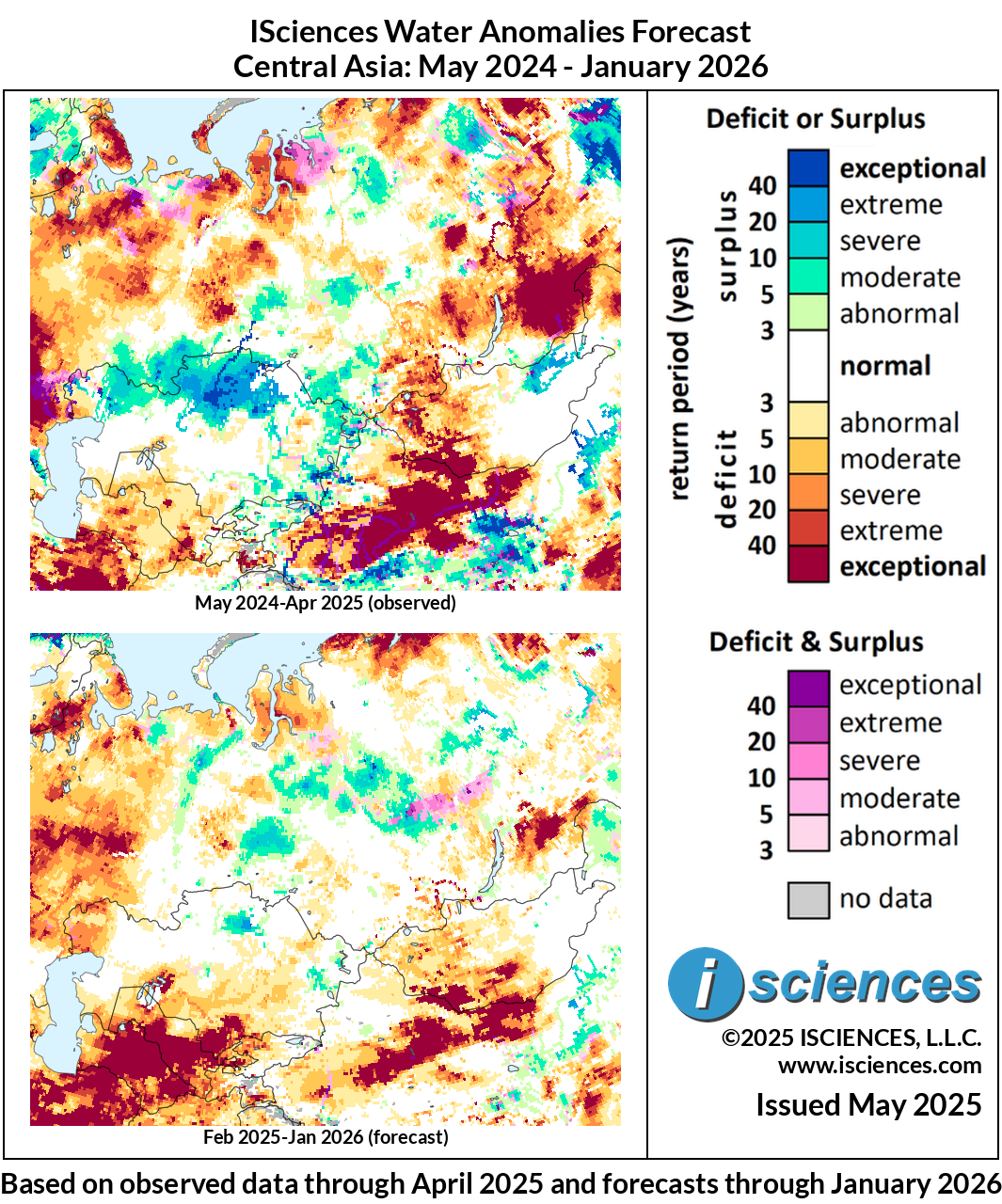Central Asia & Russia: Deficits to occur in Buryatia, Central Asia, European Russia
27 May 2025
THE BIG PICTURE
The forecast for the 12-month period ending in January 2026 indicates that exceptional deficits will persist in regions east of Lake Baikal, northern coastal Russia, and regions of Central Asia and European Russia. Surpluses are expected to continue in isolated portions of northern Kazakhstan and central Russia.
Severe to exceptional deficits are expected in:
Southeastern Russia, in the Republic of Buryatia, in regions east of Lake Baikal.
Northern Russia, in the northern coastal areas of the Yamalo-Nenets Autonomous Okrug.
Northern Russia, in the northern coastal regions of Taymyrsky DolganoNenetsky District.
Southern Kazakhstan, in areas surrounding the Aral Sea.
Uzbekistan and Turkmenistan, widespread throughout both countries, as well as in western Kyrgyzstan.
Severe to exceptional surpluses are anticipated in:
Central Russia, in southern portions of Khanty-Mansi Autonomous Okrug and northeastern Komi Republic, as well as south-central Krasnoyarsk Krai.
North-central Kazakhstan, in areas north of the city of Astana.
Transitional conditions are predicted to occur in:
Central Russia, Isolated regions of southern Krasnoyarsk Krai.
The 3-month maps (below) show the evolving conditions in more detail.
FORECAST BREAKDOWN
The forecast through July 2025 indicates that exceptional deficits will occur in Buryatia, northern coastal Krasnoyarsk Krai, peninsular Yamalo-Nenets Autonomous Okrug, and western portions of European Russia. Exceptional deficits are also expected in regions of southern to southeastern Kyrgyzstan, central to eastern Turkmenistan, and regions along the southeastern region of Kazakhstan. Severe to exceptional surpluses are expected to linger in areas near the Turukhansky District in Krasnoyarsk Krai, the city of Novy Urengoy, and northeastern Komi Republic. Further south, severe to extreme surpluses are expected in isolated regions of northern and eastern Kazakhstan.
From August through October 2025, near-normal conditions are expected throughout most of Russia and Central Asia. Surpluses are expected to continue in northern and eastern Kazakhstan, as well as in central regions of Russia’s Krasnoyarsk Krai. Exceptional deficits are expected in northern coastal regions of Krasnoyarsk Krai and in southwestern European Russia in the Ural Federal District. Central regions of Irkutsk Oblast should expect severe deficits.
The forecast for the final months – November through January 2026 – indicates that near-normal conditions will continue throughout most of Russia and Central Asia. Exceptional deficits may continue in northern coastal regions of Krasnoyarsk Krai. Isolated pockets of moderate to severe surpluses will continue in portions of central Russia and in central and eastern Kazakhstan.
Please note that WSIM forecast skill declines with longer lead times.
IMPACTS
Russia’s largest grain region, Rostov, is expected to yield a significantly reduced harvest due to the compounding impact of heat, drought, and recent spring frosts. On May 19th, Rostov declared an agricultural state of emergency, which allows farmers to seek compensation through insurance. Insurance payments to farmers linked to destructive weather grew by 76% in 2024. Rostov is the third major grain-producing region in Russia to declare an emergency, following Voronezh and Belgorod.
Russia has declared a federal-level state of emergency in the Zabaikalsky region as wildfires rage in vast areas of forest, currently accounting for 92% of all forest fire zones in the country. The fires are largely attributed to human activity, particularly the burning of dry grass, as well as early spring conditions and reduced snow cover. In late April, 44 active wildfires were burning across nearly 194,300 hectares. So far this year, over 680 wildfires have burned more than 178,000 hectares nationwide.
Vegetable prices in Russia have sharply increased over the past year, largely due to drought decreasing crop yields. Specific crops affected by price increases are potatoes (up 166.5%), onions (87.2%), and cabbage (56.8%). Drought and water shortages in key growing regions such as Volgograd have also severely affected onion and cabbage harvests. In response, the Agriculture Ministry plans to expand vegetable planting to stabilize prices. Meanwhile, food inflation is straining household budgets, as Russians now spend 34.6% of their income on groceries – a record high.
NOTE ON ADMINISTRATIVE BOUNDARIES
There are numerous regions around the world where country borders are contested. ISciences depicts country boundaries on these maps solely to provide some geographic context. The boundaries are nominal, not legal, descriptions of each entity. The use of these boundaries does not imply any judgement on the legal status of any territory, or any endorsement or acceptance of disputed boundaries on the part of ISciences or our data providers.
Subscribe to our monthly Water Watch List
Search blog categories
- *Precip/Temp Outlooks 101
- *Press Releases 1
- *Special Topics 21
- *Water Watch Lists 127
- Africa 130
- Australia & New Zealand 114
- Canada 116
- Central Asia & Russia 114
- East Asia 115
- Europe 121
- Impact Highlights 1
- Mexico & C. Amer. & Carib 119
- Middle East 124
- Proof Point 2
- South America 130
- South Asia 120
- Southeast Asia & Pacific 123
- United States 120
Search blog tags



